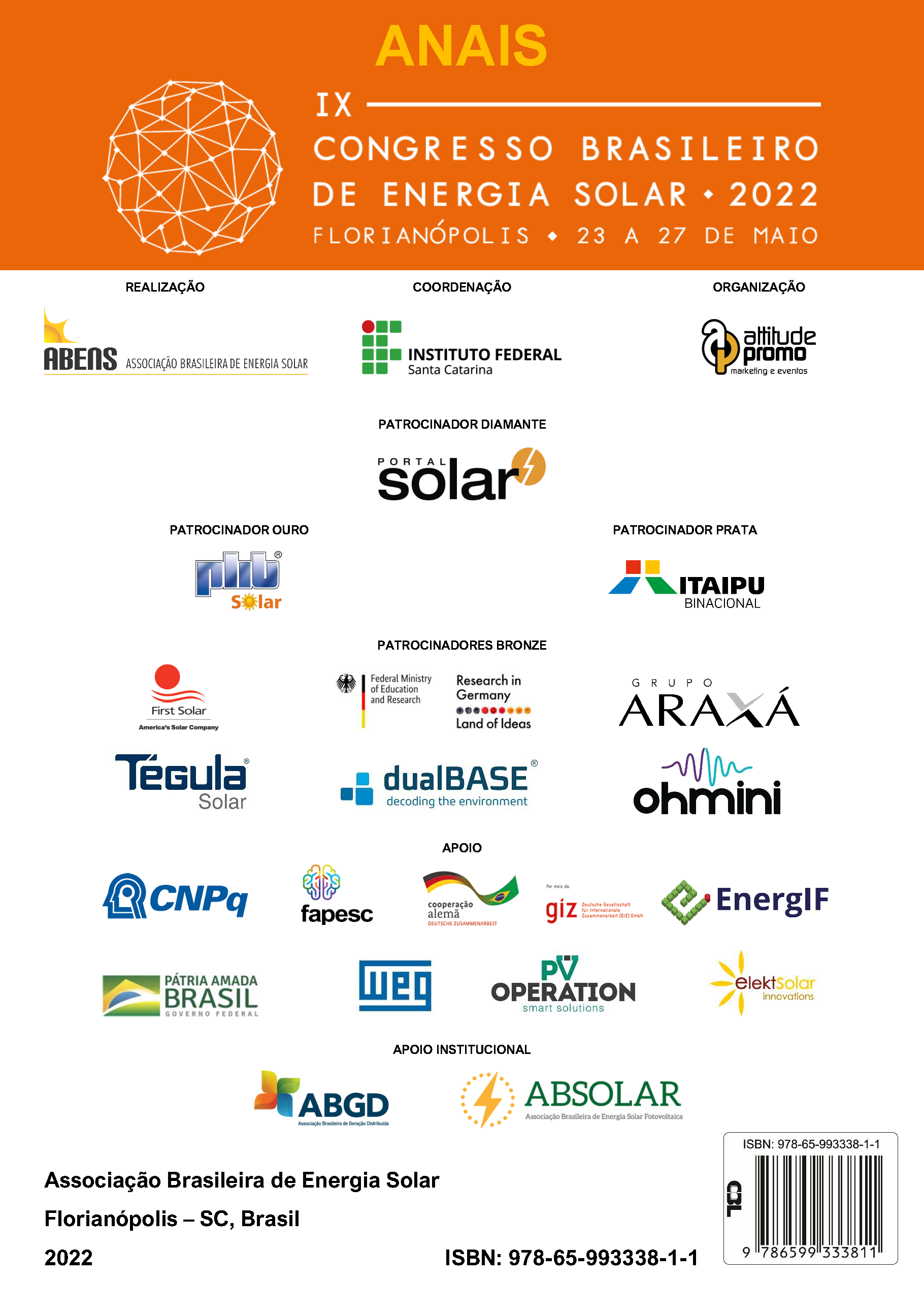ESTIMAÇÃO DE PARÂMETROS DE MÓDULOS FOTOVOLTAICOS PELO MÉTODO DA OTIMIZAÇÃO DO MAPEAMENTO DA MÉDIA E VARIÂNCIA
DOI:
https://doi.org/10.59627/cbens.2022.1117Palavras-chave:
Sistema fotovoltaico real, Estimação de parâmetros, MVMOResumo
A energia elétrica gerada por um módulo fotovoltaico é totalmente dependente das condições atmosféricas, e com a crescente expansão do mercado de energia fotovoltaica torna-se imprescindível o desenvolvimento de modelos e técnicas que permitam prever, com precisão, as saídas características do sistema em condições reais de operação, haja vista que os fabricantes dos módulos fotovoltaicos disponibilizam somente os dados em STC. Neste trabalho é realizada a estimação dos parâmetros do modelo matemático da célula fotovoltaica de 1 diodo por meio de dados coletados em um sistema fotovoltaico real utilizando a técnica heurística MVMO (Otimização do Mapeamento da Média e Variância). Os parâmetros Isc, Voc, n, Rs e Rsh foram estimados entre os limites máximos e mínimos estabelecidos utilizando os dados de corrente, tensão, irradiação e temperatura coletados durante 3 dias. Os melhores parâmetros estimados foram selecionados de acordo com o menor valor da função aptidão. Os parâmetros finais foram obtidos da média dos parâmetros estimados em todas as simulações realizadas. Os resultados mostram que o MVMO em conjunto com o modelo de 1 diodo se mostrou adequado e eficaz para a estimação de parâmetros, apresentando erro quadrático médio geral de 0,024 e propiciando ajuste satisfatório nas curvas de potência e I-V frente aos dados reais do sistema e dados de ensaios de laboratório. Os parâmetros finais estimados apresentaram diferenças de 0,11% à 9,6% em relação aos parâmetros de referência.
Downloads
Referências
Abdel-Basset, M., El-Shahat, D., Chakrabortty, R. K., Ryan M., 2021. Parameter estimation of photovoltaic models using an improved marine predator’s algorithm, Energy Conversion and Management, vol. 227, pp. 113491.
Ayang, A., Wamkeue, R., Ouhrouche, M., Djongyang, N., Salomé, N. E., Pombe, J. K., Ekemb, G., 2019. Maximum likehood parameters estimation of single-diode model of photovoltaic generator, Renewable Energy, vol. 130, pp. 111-121.
Brano, V. L., Ciulla, G., 2013. An efficient analytical approach for obtaining a five parameters model of photovoltaic modules using only reference data, Applied Energy, vol. 111, pp. 897-903.
Chin, V., Salam, Z., Ishaque, K., 2015. Cell modelling and model parameters estimation techniques for photovoltaic simulator application: A review, Applied Energy, vol. 154, pp. 500-519.
Chychykina L., Wolder, C., 2017. Comparison of different redispatch optimization strategies, IEEE Manchester PowerTech, Manchester, England.
Erlich, I., Venayagamoorthy, G. K., Worawat, N., 2010. A mean-variance optimization algorithm, IEEE Congress on Evolutionary Computation, Barcelona, Spain.
Gholami, A., Ameri, M., Zandi, M., Ghoachani, R., 2021. A single-diode model for photovoltaic panels in variable environmental conditions: Investigating dust impacts with experimental evaluation, Sustainable Energy Technologies and Assessments, vol. 47, pp. 101392.
Globo Brasil, [201-?]. Módulo fotovoltaico de silício policristalino, Folha de dados.
Gomes, G. J. N., 2020. Development of software for parameter estimation and its application on wind power plant equivalent model, Dissertação de mestrado, PPGEE, USP, São Carlos.
Hassan, H. M., Sulaiman, I. A., Singh, M., Gupta, P., Sahni, M., Rajoriya, M., 2020. Exploratory modelling and simulation of InGaN as a basis of comparison between single and double diode models of PV devices, Materials Todays: Proceedings, https://doi.org/10.1016/j.matpr.2020.11.038
Kumar, C., Raj, T. D., Premkumar, M., Raj, T. Dhanesh, 2020. A new stochastic slime mould optimization algorithm for the estimation of solar photovoltaic cell parameters, International Journal for Light and Electron Optics, vol. 223, pp. 165227.
Lemes, F., Cari, E., Corrêa, V., 2019. Parameter estimation of photovoltaic system using real condition data, IEEE Canadian Conference of Electrical and Computer Engineering, Edmonton, Canada.
Lidaighbia, S., Elyaqoutia, M., Assalaoua, K., Hmamoub, D. B., Saadaouia, D., H’roura, J., 2021. Parameter estimation of photovoltaic modules using analytical and a numerical/iterative approaches: a comparative study, Materials Today: Proceedings, https://doi.org/10.1016/j.matpr.2021.10.021.
Lopes, S. M. A., Cari, E. P., Hajimirza, S., 2021. A comparative analysis of artificial neural networks for photovoltaic power forecast using remotes and local measurements, Journal of Solar Energy Engineering, https://doi.org/10.1115/1.4053031.
Mendalek, N., Al-Haddad, K., 2017. Photovoltaic system modeling and simulation, ICIT – IEEE International Conference on Industrial Technology, Toronto, Canada.
Pillai, D., Rajasekar, N., 2018. Metaheuristic algorithms for PV parameter identification: A comprehensive review with an application to threshold setting for fault detection in PV systems, Renewable and Sustainable Energy Reviewns, vol. 82, pp. 3503-3525.
Premkumar, M., Babu, T. S., Umashankar, S., Sowmya, R., 2020. A new metaphor-less algorithms for the photovoltaic cell parameter estimation, International Journal for Light and Electron Optics, vol. 208, pp. 164559.
Ruschel, C. S., Gasparin, F. P., Krenzinger, A., 2021. Experimental analysis of the single diode model parameters dependence on irradiance and temperature, Solar Energy, vol. 217, pp. 134-144.
Villalva, M. G., Gazoli, J. R., Ruppert Filho, E., 2009. Comprehensive approach to modeling and simulation of photovoltaic arrays, IEEE Transactions on Power Electronics, vol. 24, pp.1198-1208.
Weng, X., Heidari, A., Liang G., Chen, H., Ma, X., Mafarja, M., Turabieh, H., 2021. Laplacian Nelder-Mead spherical evolution for parameter estimation of photovoltaic models, Energy Conversion and Management, vol. 243, pp. 114223.


